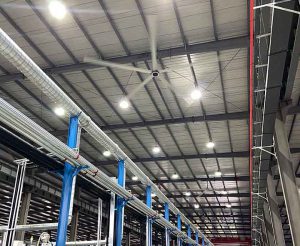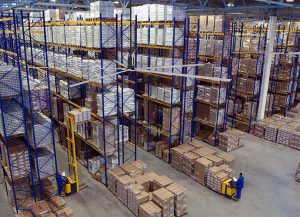Indoor climates can feel stifling when conventional fans fail to circulate air, especially in large industrial or commercial spaces. Energy bills surge, and productivity slips. An HVLS fan—with its broad span and low speed operation—provides an impactful way to reduce these pains and transform your workspace efficiently.
HVLS fans are expensive because they use high-volume, low-speed technology to move enormous amounts of air throughout expansive areas. These fans are designed with advanced motors, specialized fan blades, and durable materials to ensure long-term performance and energy-efficient operation in commercial and industrial settings. Despite the higher purchase price, many businesses recoup costs through lower utility bills, improved air quality, and reduced hvac demands, making them a cost-effective investment over time.

HVLS fan in commercial and industrial settings
An HVLS fan—short for high-volume, low-speed fan—moves a substantial volume of air with slowly rotating blades. Unlike a small ceiling fan, it’s not designed to blast a narrow stream of wind. Instead, it circulates a massive cubic area gently, reaching the floor level and pushing air throughout the facility.
Key Features of HVLS Fans
Fun Fact: Many commercial and industrial buildings use an HVLS approach to reduce their reliance on traditional cooling systems—especially in large spaces such as a warehouse or distribution center.
In many ways, yes. Industrial fans often operate on high RPM to generate localized airflow, but HVLS stands out by delivering a gentle, uniform breeze across wide zones. That’s why these fans are designed with specialized motors and robust construction to handle the demands of large commercial and industrial spaces.
A ceiling fan typically offers decent airflow in smaller rooms—like offices or homes. By contrast, an HVLS fan is built for commercial or industrial spaces, which often feature high ceiling heights and larger footprints. Although both hang from above, the average ceiling fan rarely exceeds a diameter of 12 feet, while an HVLS model can span up to 24 feet.
HVLS Ceiling Fans vs. Traditional Ceiling Fans
| Feature | Traditional Ceiling Fan | HVLS Ceiling Fans |
|---|---|---|
| Typical Diameter | Up to 5–6 feet | 8–24 feet |
| Target Application | Smaller rooms, homes | Large industrial or commercial facilities |
| Airflow Coverage | Narrow, immediate area | Spreads air throughout large zones |
| Energy Consumption | Moderate to high | Typically use less energy due to low-speed tech |
Tip: Because hvls fans typically feature robust motors and special fan blades, they produce a cost-effective climate solution for commercial and industrial spaces.
The benefits of hvls fans stretch beyond simple cooling. By generating air circulation with high-volume capability and low speed, HVLS solutions can transform an entire environment.
Case Study: A gym installed an HVLS fan in its basketball court and noted that users feel up to 8 degrees cooler thanks to the gentle breeze.
You might ask, “If it’s just a big fan, why does it cost so much?” The cost of an hvls can be higher due to specialized engineering, premium materials, and advanced motor technology. For large industrial usage, these fans must handle challenging conditions, like dust, heat, or moisture, without compromising airflow or reliability.
Expert Note: The purchase price is indeed higher up front, but these fans often pay for themselves in less than two years once you factor in energy savings and lower maintenance costs.
large industrial usage of hvls fan
Select the right HVLS fan by examining your building’s dimension, ceiling heights, occupant comfort requirements, and hvac strategy. Start by calculating the area in square feet. Then figure out if you need one or multiple fans to achieve total coverage.
Quote: “Selecting the right HVLS fan also ensures your fan operates in synergy with your overall hvac plan, possibly letting you set the thermostat higher to save electricity,” shares an HVAC consultant.
hvls fan pay refers to the fan’s return on investment (ROI). Often, the initial upfront cost might seem steep, but these fans can save up to 3 percent or more on your energy bills for each foot of vertical rise in a large facility. This is because destratifying the air helps you use your heaters or AC units more efficiently.
ROI Example: For many large commercial and industrial spaces, the combined energy savings and fewer repairs mean the fan’s price can be recouped in less than two years.
Installing hvls fans in your warehouse or distribution center is sensible when you notice temperature stratification—hot air up top, cold air near the floor level. It’s also beneficial if you’re struggling with high utility expenses or occupant discomfort.
Consider installing them if you have large spaces with moderate to tall ceiling—some facilities boast rafters over 30 feet high. An HVLS system can drastically improve comfort and reduce winter heating bills or summer cooling demands.

HVLS large industrial fan installation in warehouse
hvls fans work by generating massive air columns at low-speed, effectively pushing them downward so the air spreads out horizontally. This wave of air then rises back along the perimeter, creating a continuous flow known as destratification.
| HVLS Fans Work Mechanics | Description |
|---|---|
| High Volume | They shift huge amounts of indoor air using large blades, often up to 24 ft. |
| Low Speed | They spin slowly, which means minimal energy usage yet broad coverage. |
| Air Streams | The downward movement hits the ground, dispersing outward to refresh the entire area. |
Fans are designed to operate in synergy with your existing cooling systems or heating. By running them, you can keep your thermostat a few degrees higher in summer or lower in winter without sacrificing comfort. This method also reduces mold growth by eliminating damp air pockets.
hvls ceiling fans typically appear in large commercial and industrial spaces such as factories, gyms, or retail warehouses. Their broad coverage is especially beneficial in areas with expansive layouts, tall ceiling heights, or high occupant density.
Note: If your facility’s ceiling is under 12 to 12 feet, a smaller HVLS or a robust standard fan might suffice. But for mid to tall ceilings, HVLS is a prime solution.
HVLS fans rank among the most cost-effective solutions for climate control in large industrial or commercial buildings, especially if you seek energy efficiency without constant AC or heating usage.
Reasons HVLS is Cost-Effective
Impact on ROI: Over time, these fans not only slash energy consumption but also deliver intangible benefits like better morale, higher productivity, and improved occupant retention in your facility.
Some Hvls fans also come with advanced motors, built-in sensors, and digital control panels. These features can impact the cost, but they also ensure your fan operates reliably for years with minimal fuss. Some premium brands even offer a function to run in reverse, dispersing hot air downward in winter.
Fans Have Revolutionized big-building comfort with these extras:
How much air can an HVLS fan move?
An hvls fan can move tens of thousands of cubic feet of air per minute thanks to fan blades that range from 12 feet up to 24 feet. The exact coverage depends on the diameter and shape of the blades.
Is it true that HVLS fans may lower my thermostat in winter?
Yes. HVLS aids destratification, pushing hot air from the roof down, so you feel warmer at the ground level. This means you can dial the thermostat down for energy savings—a way to reduce winter overhead costs.
Does a commercial property can save money using HVLS fans?
Absolutely. Many commercial and industrial building owners report they save up to 3 percent or more percent on its cooling bill when they raise the thermostat but maintain occupant comfort. Over time, such energy efficient strategies add up to big savings.
Do HVLS fans require far less service than typical industrial fans?
Yes. Because HVLS fans revolve slowly and are well-built, they often require far less service or repairs. This contributes to less maintenance and a longer fan lifespan compared to small, high-velocity fans that degrade more quickly.
How do HVLS fans provide better air quality?
By circulating indoor air thoroughly, HVLS fans break up stagnant zones, reduce mold growth, and keep humidity stable, thereby improving air quality significantly.
Across the globe, many commercial and industrial sites have discovered HVLS fans to be cost-effective. They reduce overhead, maintain stable indoor conditions, and use less energy than running multiple standard fans. One example is a large distribution center that installed HVLS units on ceiling heights above 30 feet:
Reminder: Proper installation and routine inspections help maintain air circulation benefits while prolonging the fan’s life.
Although HVLS fans are typically associated with large industrial floors, they can prove beneficial in smaller spaces—for example, a midsize auditorium, a big-box retail environment, or an automotive workshop.
A brand like vindusfans set the stage for HVLS success, introducing advanced drive systems that cut power usage dramatically. Over the past decade, hvls fans provide more than mere ventilation: they shape occupant well-being, slash overhead, and improve air quality across the board.
Fans have revolutionized how we approach climate control in large buildings—particularly those with tall ceilings and wide floor plans.
HVLS fans typically have a steeper purchase price, but the cost of an hvls system quickly balances out thanks to energy savings, improved occupant comfort, and less maintenance demands. They’re not just an upsized ceiling fan: these specialized industrial fans shift massive volumes of air at low-speed, ensuring better air circulation and a more stable indoor climate in the long run.
By understanding the real reasons behind the seemingly high price tag—specialized engineering, premium materials, advanced automation, and the capacity for high volume low speed operation—you can see why an hvls fan pay model is more than justified. These fans are a cost-effective solution that, over time, deliver a wealth of benefits—such as enhanced comfort, use less energy, airflow optimization, and a healthier bottom line. If you’re ready to find the perfect HVLS solution, reach out to our hvls fans manufacturing team to explore how an HVLS upgrade might transform your commercial and industrial spaces for years to come.

Hi, I’m Michael Danielsson, CEO of Vindus Fans, with over 15 years of experience in the engineering and design industry. I’m here to share what I’ve learned. If you have any questions, feel free to contact me at any time. Let’s grow together!